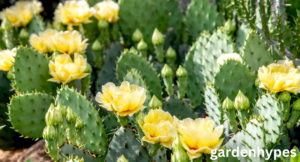Prickly PearThe Resilient Cactus Fruit with Surprising Health Benefits
Prickly pear, scientifically known as Opuntia, refers to a group of cactus species recognized by their flat paddle-like stems (pads) and colorful edible fruit known as tunas or cactus pears. Nopal (plural: nopales) is the Spanish term for the pads—an essential ingredient in Mexican cuisine and beyond
Botanical Profile & Ecology
Adaptations: The pads are cladodes—stem segments serving photosynthesis and water storage. Spines and glochids deter herbivores. The plant uses CAM photosynthesis to conserve water.
click in link rabbit resistant plants
Habitats: Native to arid regions of the Americas (Mexico, U.S. Southwest) and adapted globally in Mediterranean climates, Africa, Australia, and dry zones
Culinary Uses & Preparation
Nopales (Pads)
- Young pads can be eaten raw or cooked—used in salads, tacos, eggs, soups, and stews.
- They offer a crisp, slightly tart flavor and mucilaginous texture. Often sautéed with onions or grilled.
Tunas (Fruit)
- Tunas vary in color (green, yellow, orange, red) and taste like watermelon, kiwi, or bubblegum.
- Always peeled to remove glochids. Flesh is juicy, slightly seeded; used fresh, in juices, jellies, jams, syrups, cocktails.
Popular in beverages (aguas frescas), liqueurs such as Sicilian ficodi or Maltese bajtra.
Nutritional Value
Pads Nopales
- ~100 g raw: ~41 kcal, ~10% carbs, <1% protein/fat. 88–85% water content. Rich in fiber, magnesium, vitamin C, potassium, calcium.
Fruit Tunas
- ~100 g: ~60 kcal, ~14 g carbs, ~1 g protein/fat, high water content. Contains potassium, vitamin C, calcium, magnesium, fiber. Contains betalains and flavonoids.
Health Benefits
- Fiber-rich: Both pads and fruit support digestion and may help reduce cholesterol.
- Blood sugar control: Helps slow carbohydrate absorption—may benefit type 2 diabetes management
- Anti-inflammatory & antioxidant: Betalains, flavonoids, phenolic compounds support cellular health and reduce inflammation.
- Cardiovascular support: Nutrients like potassium, magnesium, calcium support healthy blood pressure; antioxidants support heart health.
- Hangover relief: Some studies suggest it can reduce symptoms like nausea and dry mouth when consumed before alcohol.
click in link rabbit resistant plants

Traditional & Folk Uses
- Folk medicine: Indigenous Mesoamerican people used the cactus pulp to treat wounds, ease digestive/urinary inflammation and to stop bleeding
- Cochineal dye production: Dactylopius cochineal insects feed on Opuntia, producing carmine dye used historically and commercially.
Economic & Industrial Uses
- Agriculture: Used as forage and supplemental feed in drought areas due to high water and nutrient content.
Innovative industries: Italian startup aims to produce juices, flour, biofuel, and plant-based leather from cactus pads. Low-water, sustainable crop.
Traditional uses: Extracts from sap used in rural Mexico for candles, chewing gum, fabric stiffening, whitewash additives.
Cultivation & Gardening Tips
- Soil & Light: Requires well-draining, sandy/rocky soil and full sunlight (6–8 h/day).
- Watering: Drought tolerant—water when soil is fully dry; avoid overwatering.
- Propagation: Remove a pad, let it callus, then plant in dry, sandy soil. Rooting takes weeks
- Maintenance: Prune to remove damaged pads, control size; use gloves to avoid spines and glochids. Cold-hardy species exist for temperate gardens.
Wildlife & Environmental Benefits
- Provides food and water for animals: birds, tortoises, insects thrive on fruit, pads, flowers
- Supports arid ecosystems, erosion control, and carbon sequestration with CAM metabolism. Recognized globally in sustainable cropping strategies.
Risks & Misconceptions
- Glochids (tiny hairlike spines) can irritate skin, throat or lips if fruit/pads aren’t properly peeled/cleaned.
- Excessive ingestion of seeds may cause constipation or rare fecal impaction.
- Large-scale infestations by pest cochineal (D. opuntiae) in places like Brazil harmed agricultural cactus crops..
click in link rabbit resistant plants

Conclusion
Prickly pear cactus is more than just a spiky desert aesthetic—it’s a nutritional powerhouse, a sustainable crop, and a cultural symbol. With centuries of culinary and medicinal use, modern science continues to uncover its benefits for heart health, digestion, inflammation, and more. Whether you enjoy it in fresh juice, grilled pads, jams, skincare products, or as part of regenerative agriculture, the prickly pear stands strong as nature’s resilient marvel.
Want to know about specific recipes, skincare uses, or growing tips tailored to your region? Just say the word
FAQs
- Are prickly pear pads safe to eat raw?
Yes—after removing spines and glochids, young pads can be eaten raw (often added to salads or blended). They contain mucilage and fiber; some prefer cooking to reduce texture. - Can prickly pear fruit help manage diabetes?
Research suggests that consuming pads or fruit may reduce postprandial blood sugar and improve insulin sensitivity. It’s not a substitute for medical treatment but could be supportive when integrated wisely. - Is prickly pear cactus easy to grow at home?
Absolutely. It thrives in full sun and sandy soil, needs minimal water, and is propagated via pads. Avoid handling bare-handed due to glochids. Cold-hardy species exist for temperate climates. - What are the best culinary uses of prickly pear?
Nopales are great in tacos, scrambled eggs, salads, or stews. Fruits are used fresh, juiced, turned into jam, syrup, cocktails, and desserts thanks to their sweet, melon-like flavor. - Are there skincare benefits from prickly pear?
Yes—prickly pear seed oil is rich in essential fatty acids, vitamin E, and amino acids, often used in moisturizers and serums to hydrate skin, improve elasticity, and protect against inflammation and pigmentation.
